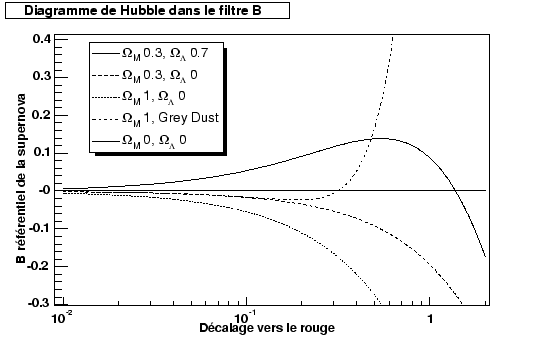 |
Aguirre showed in a series of two articles (aguirre1999a & aguirre1999b) that it was possible to reproduce the effect of a cosmological constant using gray dust. In this model, dust has sufficiently significant characteristic faces not to involve reddening, the various wavelengths being absorbed in an equivalent way.
They would thus involve a progressive extinction of supernovæ with the redshift (quantity of dust increasing with the distance). In this model, should thus see us supernovæ proportionally increasingly extinct with the distance. Figure 6.6 shows the evolution of the difference in magnitude out of B of the supernovæ of the Ia type for an empty universe and 4 typical models. The effect of gray dust is to have supernovæ increasingly weak compared to supernovædans an empty universe.
 |
As figure 6.6 shows it , for a model with cosmological constant, the effect is reversed towards a redshift around 1. At that time, the universe was dominated by the matter and thus in deceleration involving a magnification of the light of the supernovæ compared to the empty model.
The observation of a supernova to a redshift of 1.7 discovered in Hubble Deep Field northern (riess2001) showed that one observes well a magnification of this supernova compared to model of empty universe.
However, the quality of the lightcurve (the supernova was observed only at two times) and the spectral precision of the shift (given using photometry) are as many mortgages as for the cosmological conclusions.
Lastly, it seems probable that this supernova underwent a magnification
0.3 magnitude per effect of gravitational lens (morstell2001a &
benitez2002). This could be in agreement with ![]() with models of gray dust.
with models of gray dust.
Only the observation of a more significant number of supernovæ to redshifts beyond 1 will make it possible to take a decision between the various models.